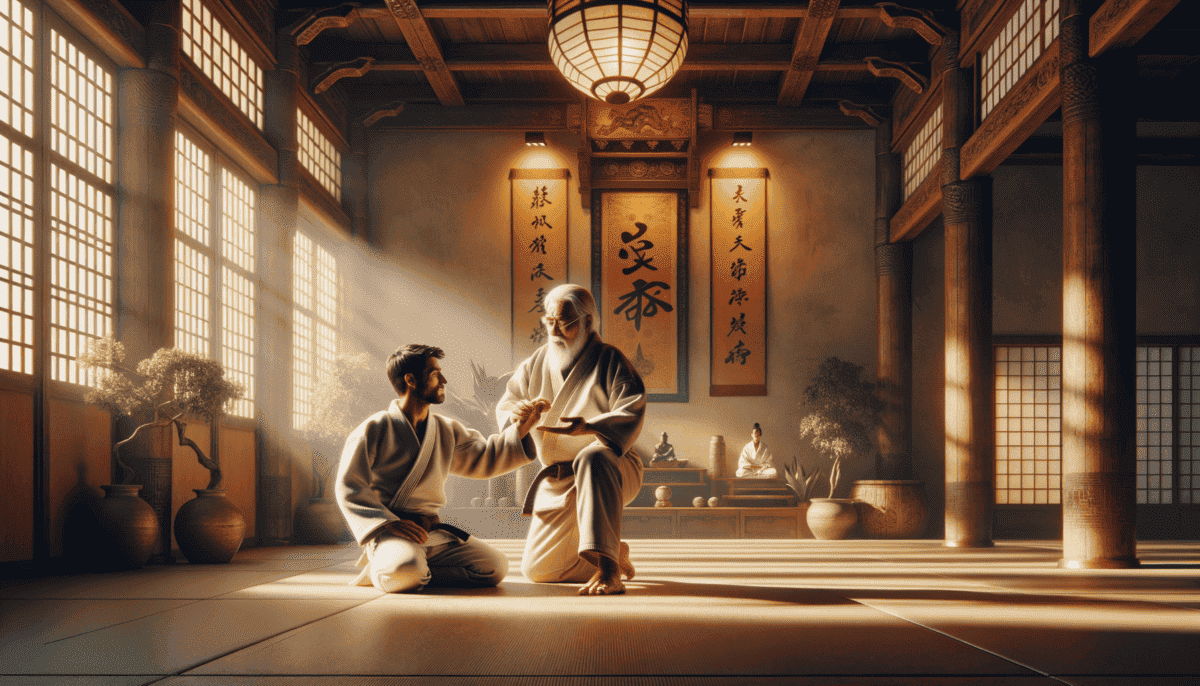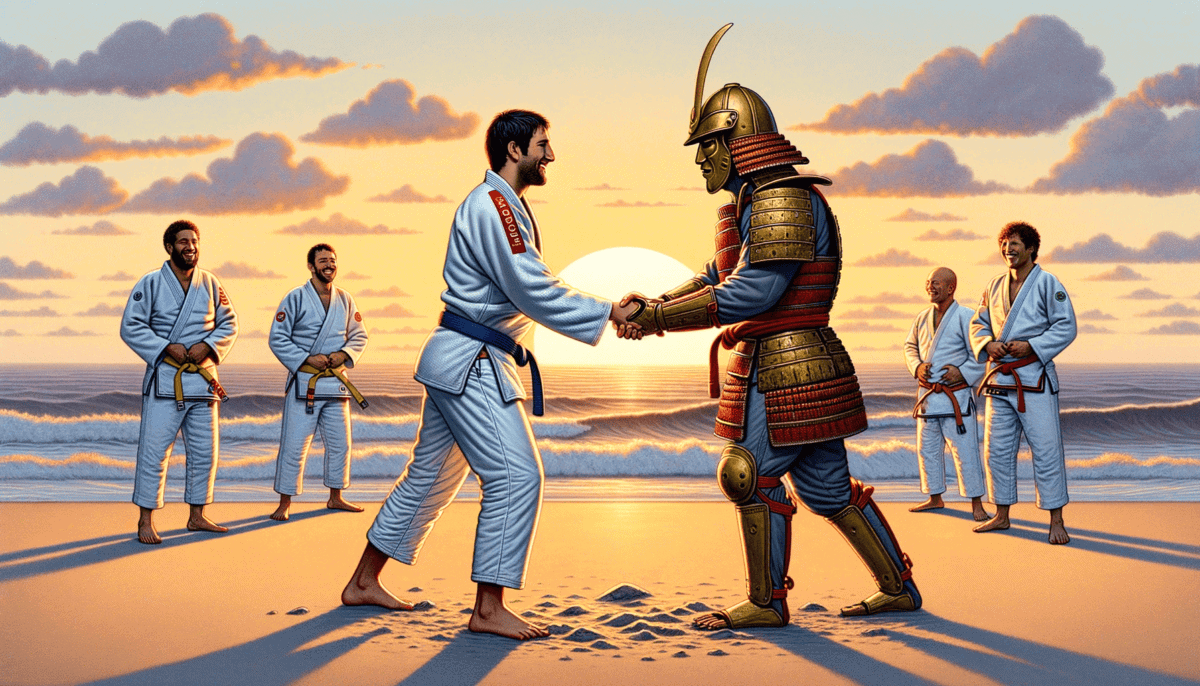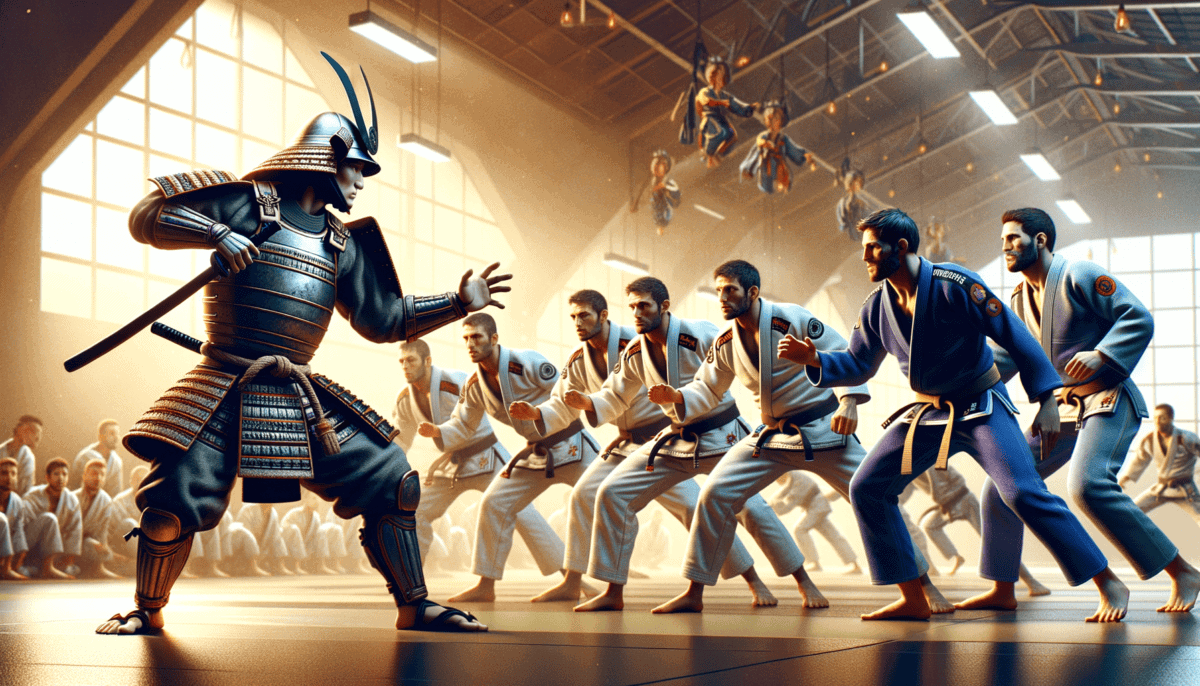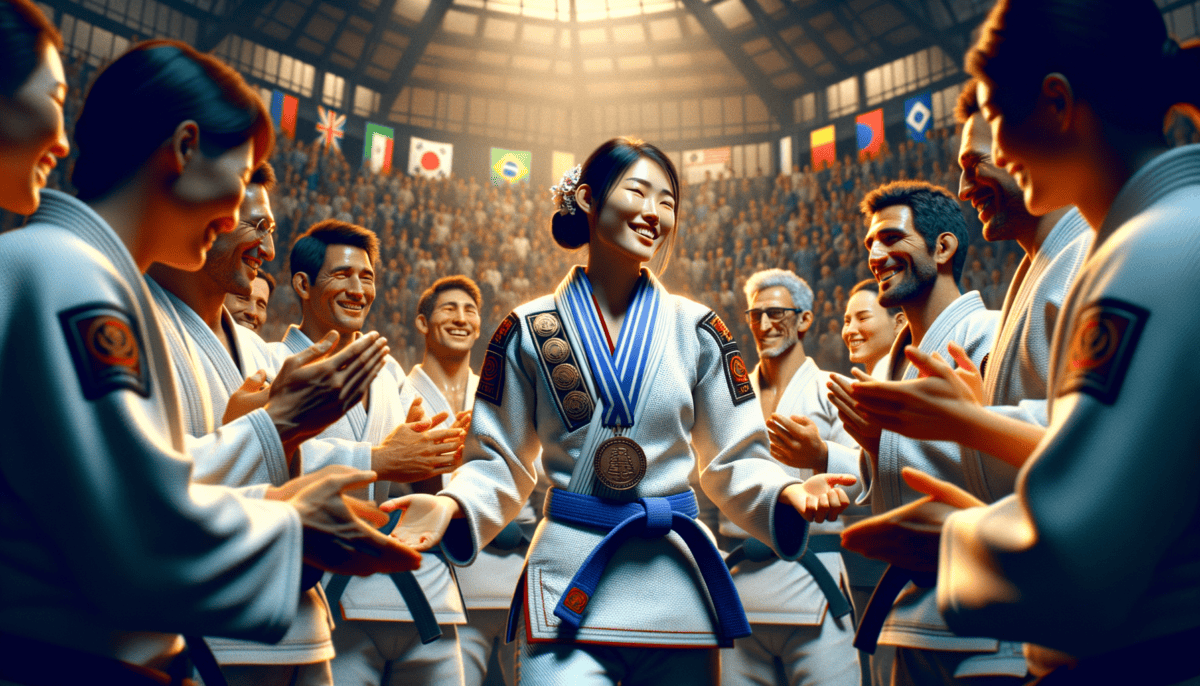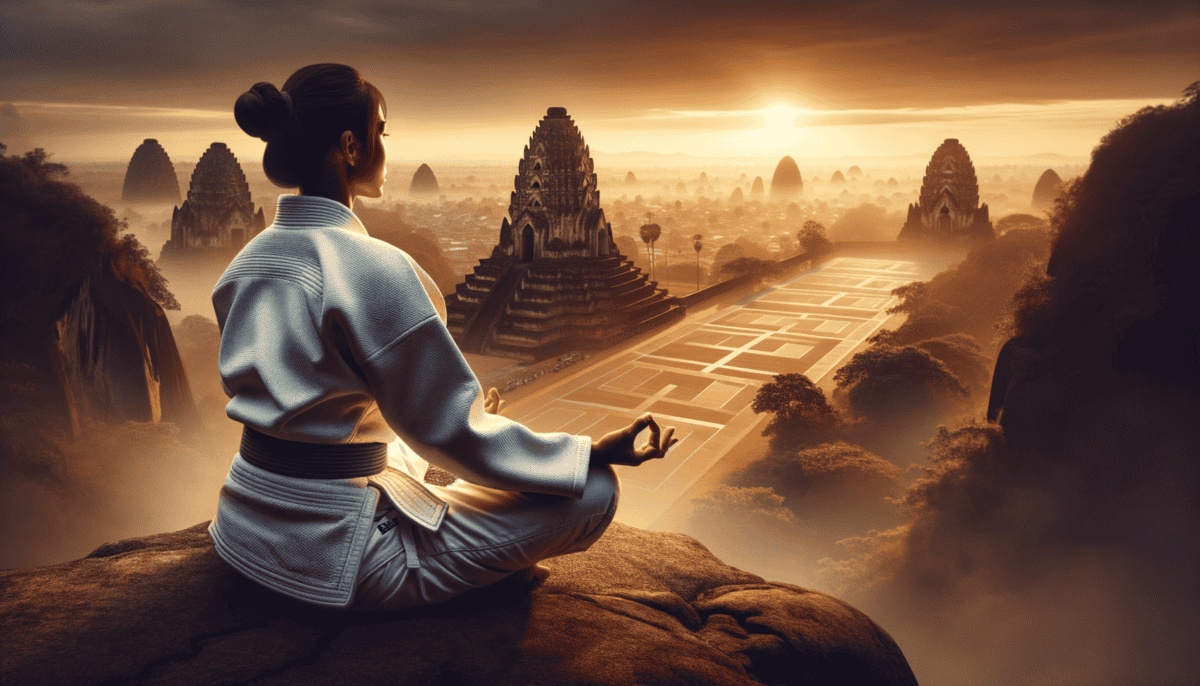The Samurai’s Secret
Long ago in Japan, brave warriors called samurai protected their land. These warriors were special. They knew how to fight with swords and spears. But they also knew something even more important – a secret way to fight without weapons. This was Jiu-Jitsu!
Picture yourself in old Japan. The air smells like cherry blossoms. You can hear the clang of swords in the distance. A samurai named Takeshi is teaching his students in a peaceful garden.
"Sometimes your sword might break," Takeshi tells his students. "Or you might lose your spear. What do you do then?"
The young students look worried. One raises his hand. "Run away?"
Takeshi smiles and shakes his head. "No, this is why we learn Jiu-Jitsu. It helps us fight without weapons."
The Secret Moves
The samurai learned special moves to:
• Pin down bigger enemies
• Use an attacker's strength against them
• Escape from tight spots
• Win fights without hurting people too badly
“In Jiu-Jitsu, we learn to be like water,” Takeshi explains. “Water can flow gentle like a stream or crash powerful like a wave. It adapts to whatever container holds it.”
The students practice on soft straw mats. They learn to roll safely when thrown. They figure out how to use leverage – that means using smart moves instead of just strength. It's like how a small child can lift a heavy rock by using a long stick as a lever.
More Than Just Fighting
But Jiu-Jitsu wasn't just about fighting. It taught important lessons:
Be patient
Stay calm under pressure
Think before acting
Never give up
"Remember," Takeshi tells his students as the sun sets, "true strength isn't about being the biggest or strongest. It's about being the smartest and most skillful."
Young samurai trained every day. They practiced moves over and over. They learned to fall without getting hurt. They discovered how to control their breathing and stay focused.
"Sensei Takeshi," asks a small student, "will I ever be as good as you?"
Takeshi puts his hand on the boy's shoulder. "With practice and patience, you might become even better. In Jiu-Jitsu, we never stop learning."
As night falls over the training ground, the students bow to their teacher. They feel tired but happy. They know they're learning something special – an art that would one day spread far beyond Japan and change many lives.
The secret of the samurai was starting to grow. But nobody knew yet how far this gentle art would travel, or how many people it would help. That was just the beginning of an amazing story that continues today.
Masters and Students
In old Japan, Jiu-Jitsu masters shared their special knowledge with care. They taught in hidden dojos – special training rooms with soft mats. Each master had their own way of teaching the gentle art.
Master Yamamoto was one of the most respected teachers. His dojo sat near a peaceful garden. Cherry blossom petals would float through the open doors while students trained.
“Remember,” Master Yamamoto would say, “Jiu-Jitsu is like planting a garden. It takes time and care to grow strong.”
The Learning Path
Students started as white belts and worked their way up through different colors. Each belt showed how much they had learned. Here’s what students had to learn:
• Simple throws and holds
• Gentle ways to control an opponent
• How to escape when grabbed
“Sensei,” a young student asked one day, “why do we practice the same moves so many times?”
“A technique done once is just learned. A technique done thousand times becomes part of who you are,” Master Yamamoto answered with a smile.
Special Training Methods
The masters had clever ways to teach:
Using wooden dolls for practice
Teaching through stories and sayings
Training in nature to build strength
Learning to feel movement instead of just seeing it
Students practiced in pairs. The bigger ones learned to be gentle. The smaller ones learned to be clever. Everyone helped each other get better.
More Than Just Moves
Masters taught important ideas too:
“Be strong like the bamboo,” Master Yamamoto would say. “It bends in the storm but doesn’t break.”
• Stay calm when things get hard
• Help others learn
• Never use Jiu-Jitsu to hurt people
• Keep practicing even when tired
Young students would watch the older ones practice. They saw how years of training made movements smooth like flowing water. It gave them something to work toward.
“Will we ever learn all there is to know?” asked a curious student.
Master Yamamoto laughed softly. “Even after teaching for forty years, I still learn new things. That’s the beauty of Jiu-Jitsu – there’s always more to discover.”
Passing Down Wisdom
The best students became teachers themselves. They opened their own dojos and shared what they learned. This kept Jiu-Jitsu growing and changing.
Some students wrote down the techniques in special books with pictures. Others made wooden training tools to help new students learn. Everyone worked together to keep the art alive.
As the sun set each day, students would bow to their master and to each other. They felt proud of what they learned and excited to come back tomorrow. The wisdom of Jiu-Jitsu was growing stronger with each new generation.
But soon, this special art would travel far beyond Japan’s shores. A new chapter in the story of Jiu-Jitsu was about to begin…
Crossing the Ocean
In 1914, a special ship sailed from Japan to Brazil. On board was Mitsuyo Maeda, a Jiu-Jitsu master. He carried with him the ancient wisdom of the samurai.
When Maeda arrived in Brazil, he met a young man named Carlos Gracie. Carlos was amazed by Maeda’s skills. He had never seen anything like it before!
A New Family of Warriors
“Please teach me,” Carlos asked Maeda. The master agreed, and Carlos became his student. Every day, they trained together on the mats.
“In Jiu-Jitsu, the small can defeat the big,” Maeda told Carlos. “It’s not about strength – it’s about being smart.”
Carlos loved Jiu-Jitsu so much that he taught his whole family. His brother Helio was small and not very strong. But Helio found clever ways to make the moves work for him.
Making It Their Own
The Gracie family changed Jiu-Jitsu to make it even better. They added new moves and focused on fighting from the ground. This new style became known as Brazilian Jiu-Jitsu.
• Using less strength
• Fighting from your back
• Clever ways to win
• Teaching everyone, not just warriors
Soon, the Gracies opened their own school. People came from all over Brazil to learn. Even strong fighters were surprised when small Jiu-Jitsu students could beat them!
Spreading the Art
The Gracie family worked hard to share their art:
They taught police officers
They showed moves on TV
They wrote books about Jiu-Jitsu
They invited people to test their skills
“Everyone should learn Jiu-Jitsu,” Helio would say. “It makes you strong in body and mind.”
Growing Bigger
More and more people wanted to learn Brazilian Jiu-Jitsu. Students came from other countries to train with the Gracies. Each person who learned took the art back to their home.
• It worked really well
• Anyone could learn it
• It was fun to practice
• It taught good values
Young students learned just like Carlos did years ago. They practiced moves over and over. They learned to be patient and kind. The spirit of both Japan and Brazil lived in their training.
A New Chapter Begins
The Gracie family had children who also learned Jiu-Jitsu. They grew up to be great teachers too. Each generation made the art even better.
“What’s different about Brazilian Jiu-Jitsu?” a student once asked.
Helio smiled and said, “We made it work for everyone, not just the strong. That’s the magic of our art.”
As Brazilian Jiu-Jitsu grew, it started to change from just self-defense into something new. People began to compete in friendly matches. They wanted to test their skills and have fun.
The journey of Jiu-Jitsu was far from over. From the dojos of Japan to the beaches of Brazil, it kept growing and changing. Now it was ready to become something even bigger – a sport that people all over the world would love…
A New Kind of Battle
The mats squeaked under bare feet as students stepped onto them. It wasn’t a battlefield anymore – it was a bright gym with mirrors on the walls. Jiu-Jitsu had found a new home!
Learning to Play
Teachers made new rules so people could practice safely. They used colored belts to show how much someone had learned. White belts were beginners, and black belts were experts.
“Now we can practice without getting hurt,” said one teacher. “Everyone can try Jiu-Jitsu!”
Students learned to tap their hand when they wanted to stop. This simple rule made the sport safe for everyone. It was like saying, “Good job, you got me!”
Fun New Games
People started having contests. They weren’t fighting – they were playing a special game! The goal was to use clever moves to make your partner give up.
• Be gentle
• Follow the referee
• Show respect
• Have fun
Growing Around the World
More and more gyms opened up. You could find Jiu-Jitsu in:
America
Europe
Asia
Australia
Kids loved learning Jiu-Jitsu. It helped them make friends and feel strong. Parents liked it because it taught good values like respect and kindness.
Special Teachers
Some people worked extra hard to make Jiu-Jitsu better. They wrote books about the best ways to teach. They made videos to help students learn. They started big contests where people could show their skills.
• How to be strong
• How to stay calm
• How to solve problems
• How to help others
A Sport for Everyone
“Can I really learn?” asked a small girl at her first class.
“Of course!” smiled her teacher. “Jiu-Jitsu is for everyone – big or small, young or old!”
People of all ages came to learn. Some wanted to get strong. Others wanted to make friends. Many just thought it was fun! Everyone found something special in Jiu-Jitsu.
Looking Forward
Big contests started happening all over the world. People wore special uniforms called gis. They competed for shiny medals and cool trophies.
But something even bigger was coming. A new sport called Mixed Martial Arts would soon make Jiu-Jitsu even more famous. People would see how well it worked against other fighting styles.
The little art that started with samurai was now everywhere. It was in schools, on TV, and in gyms across the world. And it kept growing stronger every day…
Champions of Today
The crowd roars as two athletes step onto the mat. The big screen shows their names. Lights flash and music plays. This is what Jiu-Jitsu looks like today!
Meet Maria
Maria is 12 years old. She trains every day after school. Her gi (special uniform) is covered in patches from contests she won.
“I love Jiu-Jitsu because it makes me feel strong,” Maria says. “Size doesn’t matter here – skill does!”
Last week, Maria won a gold medal. But she remembers what her teacher always says: “Medals are nice, but being a good person is better.”
Big Contests
Modern Jiu-Jitsu has amazing contests. They happen in:
• Big sports arenas
• School gyms
• Parks
• Special events
More Than Just Sport
Today’s Jiu-Jitsu fighters are like superheroes! They:
Train very hard
Study nutrition
♀️ Practice mindfulness
Help others learn
Special Stories
“I was scared to try at first,” says Tom, a new student. “But everyone here is so nice!”
Sarah, who teaches kids’ classes, smiles. “That’s what Jiu-Jitsu is about – helping each other grow.”
Around the World
• In schools
• In fitness centers
• On social media
• In movies
Special Powers
People who do Jiu-Jitsu today learn special skills:
“It helps me focus better in school,” says Joey, age 10.
“I made so many friends here,” adds Lisa, age 8.
“I’m not afraid of bullies anymore,” shares Mike, age 11.
Growing Stronger
The sport keeps getting bigger! Now there are:
- Online classes
- Special kids’ programs
- Women’s only classes
- Senior citizen groups
Exciting Times
Back at the big contest, Maria steps onto the podium. She just won another medal! But she’s most proud of helping her teammate train this morning.
The old samurai would be amazed to see their art now. It teaches people to be strong AND kind. It shows that anyone can be a champion if they try hard enough.
As the lights dim in the arena, new students are just starting their first class somewhere else. The journey of Jiu-Jitsu continues, stronger than ever…
Legacy of the Gentle Art
The sun rises over a modern Jiu-Jitsu academy. Students of all ages bow as they step onto the mat. The spirit of the ancient samurai lives on here!
Every Day Heroes
Coach Alex watches his students practice. He sees something special happening. Little Emma helps Kevin learn a new move. Tim shows Maya how to tie her belt. They’re all growing together!
“Jiu-Jitsu isn’t just about fighting,” Coach Alex says. “It’s about becoming better people.”
Special Powers Growing
The gentle art keeps changing and getting better. Now there are new ways to learn:
• Smart mats that track moves
• Apps that help you practice
• Online classes with champions
Making Dreams Come True
Maria, our young champion from before, now teaches other kids. She remembers being scared on her first day.
“Now I can help new students feel brave,” she says with a big smile. “That makes me happy!”
Growing Together
Around the world, Jiu-Jitsu brings people together:
Friends from different countries
Students helping each other
Teachers sharing wisdom
❤️ Families training together
Looking Forward
• Special games for learning
• Fun ways to practice
• More chances to compete
• Better training tools
Special Moments
At the end of class, Coach Alex gathers everyone in a circle. “Remember,” he says, “we’re all on this journey together.”
The students bow to each other. They’re tired but happy. They learned new moves today. But more importantly, they learned about being good friends.
Never Ending Story
From ancient Japan to today’s gyms, Jiu-Jitsu has changed many lives. It started with samurai warriors. Now it helps kids be brave, adults stay healthy, and everyone make friends.
The story of Jiu-Jitsu isn’t over. It keeps growing and changing. But some things stay the same: being kind, working hard, and helping others.
As the students leave the mat today, they carry a piece of history with them. They’re part of something special – a story that started long ago and keeps getting better! ✨


